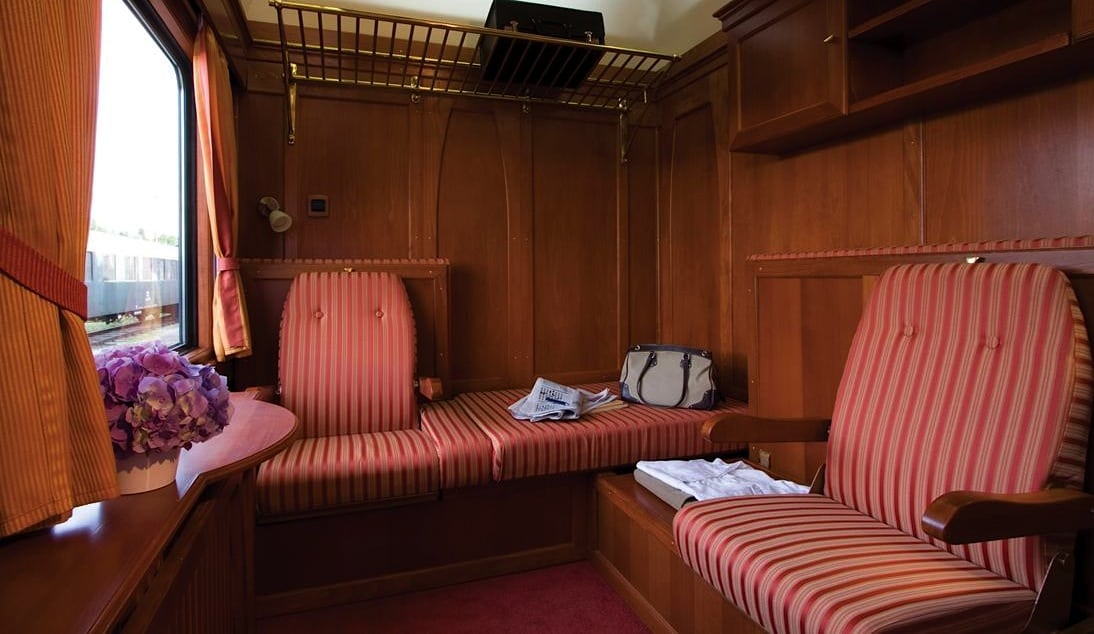Istanbul to Romania on the historic Danube Express rail line

Skift Take
It’s somewhere towards midnight, and I am hanging out of a train window, breathing in the sweet night air. The night is pitch-black and silent apart from the occasional oily creak as the wheels spark against the rails below. Beyond, out in the darkness, lies Romania, wild and unknown. Ahead lies Bulgaria; behind us the vast expanses of the Hungarian plain. We glide slowly through a village and I wave at two men sitting by an outdoor fire, bottles of beer glinting in the light from the flames. They stare at the train for a moment and then I am gone, carried along into the night as the coaches snake past the quiet streets.
There is something inescapably romantic about rail travel. Not the crammed-in-a-carriage commuter kind, but the sort of journey where one embarks in a glamorous European city, wearing Chanel and exchanging witty banter with a suave chap who later buys you a martini in the restaurant car, while the ivories are gently tinkled. Think Daniel Craig and Eva Green in Casino Royale or, even better, Cary Grant and Eva Marie Saint in North by Northwest. It’s odd, because on paper it doesn’t add up: cramped conditions, constant motion, no spa or pool or choice of restaurants. But perhaps that’s what makes rail travel so relaxing – there are no choices to deal with, no decisions to be made. The train is going where it’s going, meals will be served when they’re served and the only possible dilemma is whether to have a G & T or glass of champagne as a pre-dinner snifter. Now that’s my kind of dilemma.
Kecskemét in Hungary
I’m travelling on the Danube Express, a luxury train that once belonged to the Hungarian prime minister, János Kádár. Afraid of flying, Kádár chose to whizz between European capitals on his private train, which spent years lying disused in railway sidings before a partnership between Hungarian National Railways and Howard Trinder, the man behind the tour operator Great Rail Journeys, saw the train take to the rails once more.
Lovingly restored, the carriages hark back to the golden age of rail travel, with gleaming wood panelling, chic navy-and-white livery and, of course, pristine white tablecloths in the dining car. The sleeping cars are surprisingly spacious; a comfortable spot to watch the world whizz by during the day, and a delectably cosy bedroom at night, with fluffy white pillows and duvets and an L-shaped arrangement of beds rather than cramped bunks.
Veliko Tarnovo in Bulgaria
The train trundles its way across Eastern Europe, with a choice of four different routes, all involving visits to some of the continent’s most beautiful cities, including Budapest, Prague and Istanbul. My four-day trip began in Hungary, stopping in Romania and Bulgaria before ending in the Turkish capital – a journey through a very different Europe to the sun-kissed, sophisticated western half with which I’m much more familiar. Locations such as the Great Hungarian Plain and the Shipka Pass, and unknown towns such as Veliko Tarnovo and Sighisoara gave the itinerary a tantalising feel of journeying into the unknown.
The first late-afternoon stop at the Hungarian town of Kecskemét gave a taste of what was to come; from the spectacular domed churches to the impenetrable language on every shop front.
But it was Romania that was the real revelation. Lush wooded countryside stretched out between clusters of houses and farms, with occasional glimpses of figures trundling ploughs and carts between the fields. I’d read that Romania seems stuck in a time warp, and even in Sighisoara – a World Heritage Site and one of the best-preserved medieval towns in Europe – once away from the tourist streets of the old town, I felt as if I’d stepped into the Fifties. The high street in the newer part of town was lined with old-fashioned shops; stern-faced women holding court behind wide glass counters, clothes piled high, material leaning against the walls.
Bran Castle in Romania
Tourism has set out its stall in Romania; particularly in Transylvania, where much is made of the link to Count Dracula. A first glimpse of Bran Castle, perched high on an outcrop of rock, certainly conjured up Hammer Horror-esque images, and although the link to Vlad the Impaler – the supposed inspiration for Dracula – is pretty thin, it is a spectacular sight.
But for me, one of the greatest pleasures was returning to the train at the end of an excursion; stepping into the air-conditioned carriages and settling into the lounge car for a cold beer and little light jazz as the streets of whatever town we had visited slowly melted into open countryside. It’s an extraordinarily relaxing feeling, knowing that the next morning will bring new locations, new sights to see, and you don’t have to do anything but sit back, watch the sun set and wait for Cary Grant to pop up with a martini.
Essentials
Getting there
The Danube Express (01462 441400; danube-express.com ) offers the four-day Transylvanian East journey from £2,790 per person, including three nights in a twin en-suite compartment, all meals, wine, beer and soft drinks, sightseeing trips and the services of a train manager. Departures in 2013 are May 22, June 12 and September 18. This journey is also available from Istanbul to Budapest. The Danube Express plies three other routes, with stops in Poland, Austria, Slovakia and the Czech Republic; its longest journey, from Istanbul to Prague, takes 10 days.
Dining on board
All meals are included in the price and by far the best food we ate during our trip was served in the restaurant car of the Danube Express. Venison ragout with pumpkin purée and wild mushroom rice for our first dinner on board set the standard at a high level. Subsequent highlights included goose leg with mashed potato and braised red cabbage and raspberry chocolate mousse cake. Wine is from the Szeremley wine house and beer from Dreher, a Hungarian brewery.
You can be as sociable or as solitary as you like in the dining and lounge carriages. There is no need to share a table for lunch or dinner, although we usually chose to do so. You would have to be an incurious soul not to want to know a little more about your fellow travellers on a journey like this and we were delighted to find they included a witty Paris-based lawyer, a charming art expert from Tate Modern and some knowledgeable railway buffs from America.
What to avoid
Do not voice opinions which might be construed as criticism of the Turkish government – it can cause offence in this patriotic country.
Don’t bring your own towels and toiletries. The train’s en-suite shower rooms are sumptuously supplied and regularly replenished.
Do not take large suitcases on to the train. Compartment luggage racks are set quite high and it is easier to access two smaller cases.
Don’t bother taking local currencies for Romania and Bulgaria.
There are exchange facilities on the train but we found that euros were accepted wherever we went.
Don’t buy rugs in Istanbul. If you take them with you on the train, the encumbrance will irritate for the rest of the trip, and if you post them they will not have cost much less than if you had bought them in Britain.
When in Hungary, best not mention the 1920 Treaty of Trianon under which the country lost much of the empire it used to share with Austria. It’s still a very sore point.
Tipping on board
There is no need to tip on the Express but we were so pleased with the high standard of service throughout the trip that, on reaching our destination, we left a gratuity for staff to share.
Further reading
Try Last Call for the Dining Car: The Telegraph Book of Great Railway Journeys, edited by Michael Kerr (Aurum) and The Danube: A Cultural History, by Andrew Beattie (Aurum).
![]()




